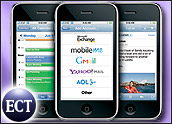
On July 11, when Apple had barely started to sell its much-anticipated iPhone 3G, Salesforce.com became the first customer relationship management vendor to announce the availability of its mobile applications for the iPhone in Apple’s App Store.
Now, two weeks after the phone’s release, a few other CRM vendors can claim some sort of iPhone 3G compatibility; many more are planning to roll out an application in the future.
This development is hardly a surprise. For starters, at the iPhone’s initial debut a year ago, a handful of CRM vendors — NetSuite, for one — pushed out applications for it, even though its functionality and connectivity were relatively basic. With the souped-up iPhone 3G and Apple’s software development kit, building sophisticated business apps is now much easier.
A Compelling Platform
That’s why Oracle chose this month to build and roll out Oracle Business Indicators — the first in a series of Oracle business applications for the iPhone, Paul Rodwick, vice president of product management for Oracle Business Intelligence, told CRM Buyer.
“We found it a very compelling platform, and the SDK is a strong development environment providing good capabilities around Web services,” he said.
It was the SDK that really helped Salesforce.com build its mobile client app for the iPhone 3G, Chuck Dietrich, vice president of Salesforce.com Mobile, told CRM Buyer. “It meant we could integrate our applications with the iPhone’s native functionality — such as e-mail, phone and maps.”
Users can navigate customer records, initiate calls from within Salesforce.com CRM, and query the system for certain data to be sent to the iPhone, using the Salesforce.com mobile application.
Although it is not coming out of Oracle’s CRM business line, Oracle Business Indicators can easily be applied in a number of related activities. For instance, it can display sales performance and customer satisfaction metrics. Contact center managers can use them to monitor performance; fulfillment managers can use them to monitor inventory, Oracle noted.
In fact, because the 3G is expected to be so popular in corporate circles — the consumer constituency is a given — optimism is cautiously building that it may do for mobile CRM what nothing else has been able to do thus far — namely, propel it into the mainstream.
Mainstream CRM?
With features like Microsoft Exchange integration, the iPhone upgrade is finally equipped to enter the business market, noted Robb Hecht, digital strategy director at IMC Strategy Lab.
“The device provides a small widget one-touch app downloadable to the iPhone desktop, which [CRM] users can log in to and access their Web-based contacts,” he told CRM Buyer. “The capability to have [mobile] access to sales contacts and relationships … gives sales teams with CRM responsibilities a convenient tool to do business with.”
Eventually, these offerings could render the iPhone “indispensable for conducting modern business — a claim [Research In Motion’s] BlackBerry currently owns,” Hecht speculated.
“I think it is a very significant device — in fact, the single most important development since Windows,” Anthony Lye, senior vice president of CRM at Oracle, told CRM Buyer. “I would go so far as to say it could be the most significant platform for CRM.”
Lye’s enthusiasm for the device is based on its potential — “We are only scratching the surface now with the kinds of things we can build on the iPhone 3G” — and on what he says has been a misguided vision of mobile CRM from the beginning.
“At first, people took CRM applications — which were designed as a manual reporting system and then optimized for the key board — and put those on a smartphone. Which no one, especially the sales reps, liked anymore than they did when they were applications for the big screen,” he said.
What the industry should have done — and is doing now, according to Lye — was build a tool that could encapsulate CRM data, personal data and enterprise resource planning data, embedding productivity tools within those applications.
Not everyone, it must be said, is expecting 3G to work miracles — and a robust mobile CRM market would be akin to miraculous. “We don’t see the vast majority of companies advancing their back-end infrastructure investments in [mobile CRM] anytime soon,” Duncan Greatwood, CEO of PostPath, told CRM Buyer. “But we do think there will be a lot more iPhone deployments in the corporate world because of the active sync capability.”
The BlackBerry isn’t going anywhere, he said, but he does envision a mix of devices in the market one day.
Next Up
Oracle will be releasing an upgraded version of its mobile sales assistant for the iPhone 3G sometime this year. “You can also expect to see from us a complete portfolio of CRM products and Web 2.0 products for the iPhone over the medium term,” Lye said.
SAP, which announced a mobile CRM offering via a partnership with RIM a few months ago, is also eyeing the iPhone market, Vinay Iyer, vice president of CRM marketing at SAP, told CRM Buyer.
Last year, the company introduced an application that was accessible through the iPhone — essentially preconfiguring some applications and views that could be accessed from the iPhone’s browser. However, it wasn’t a native application, Iyer said. “Now we are developing native apps, and we are doing that through partnerships.”
Indeed, SAP is approaching the mobile marketplace by co-delivering applications through partnerships, he said, and it is under this umbrella approach that the company will roll out SAP mobile CRM for the iPhone 3G.
“Our target is to have something on the market within six to nine months,” said Iyer.





















































